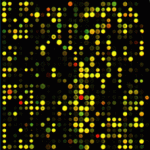Genomics
|
23 april 2012 19:50:29 |
| Complete genome sequence, lifestyle, and multi-drug resistance of the human pathogen Corynebacterium resistens DSM 45100 isolated from blood samples of a leukemia patient (BMC Genomics) |
|
Tweet Background:
Corynebacterium resistens was initially recovered from human infections and recognized as a new coryneform species that is highly resistant to antimicrobial agents. Bacteremia associated with this organism in immunocompromised patients was rapidly fatal as standard minocycline therapies failed. C. resistens DSM 45100 was isolated from a blood culture of samples taken from a patient with acute myelocytic leukemia. The complete genome sequence of C. resistens DSM 45100 was determined by pyrosequencing to identify genes contributing to multi-drug resistance, virulence, and the lipophilic lifestyle of this newly described human pathogen.
Results:
The genome of C. resistens DSM 45100 consists of a circular chromosome of 2,601,311 bp in size and the 28,312-bp plasmid pJA144188. Metabolic analysis showed that the genome of C. resistens DSM 45100 lacks genes for typical sugar uptake systems, anaplerotic functions, and a fatty acid synthase, explaining the strict lipophilic lifestyle of this species. The genome encodes a broad spectrum of enzymes ensuring the availability of exogenous fatty acids for growth, including predicted virulence factors that probably contribute to fatty acid metabolism by damaging host tissue. C. resistens DSM 45100 is able to use external L-histidine as a combined carbon and nitrogen source, presumably as a result of adaptation to the hitherto unknown habitat on the human skin. Plasmid pJA144188 harbors several genes contributing to antibiotic resistance of C. resistens DSM 45100, including a tetracycline resistance region of the Tet W type known from Lactobacillus reuteri and Streptococcus suis. The tet(W) gene of pJA144188 was cloned in Corynebacterium glutamicum and was shown to confer high levels of resistance to tetracycline, doxycycline, and minocycline in vitro.
Conclusions:
The detected gene repertoire of C. resistens DSM 45100 provides insights into the lipophilic lifestyle and virulence functions of this newly recognized pathogen. Plasmid pJA144188 revealed a modular architecture of gene regions that contribute to the multi-drug resistance of C. resistens DSM 45100. The tet(W) gene encoding a ribosomal protection protein is reported here for the first time in corynebacteria. Cloning of the tet(W) gene mediated resistance to second generation tetracyclines in C. glutamicum, indicating that it might be responsible for the failure of minocycline therapies in patients with C. resistens bacteremia. |
| 300 viewsCategory: Genomics |
 A transcriptome map of perennial ryegrass (Lolium perenne L.) (BMC Genomics) A transcriptome map of perennial ryegrass (Lolium perenne L.) (BMC Genomics)A framework genetic map for Miscanthus sinensis from RNAseq-based markers shows recent tetraploidy (BMC Genomics) 
|
| blog comments powered by Disqus |
MyJournals.org
The latest issues of all your favorite science journals on one page
The latest issues of all your favorite science journals on one page



